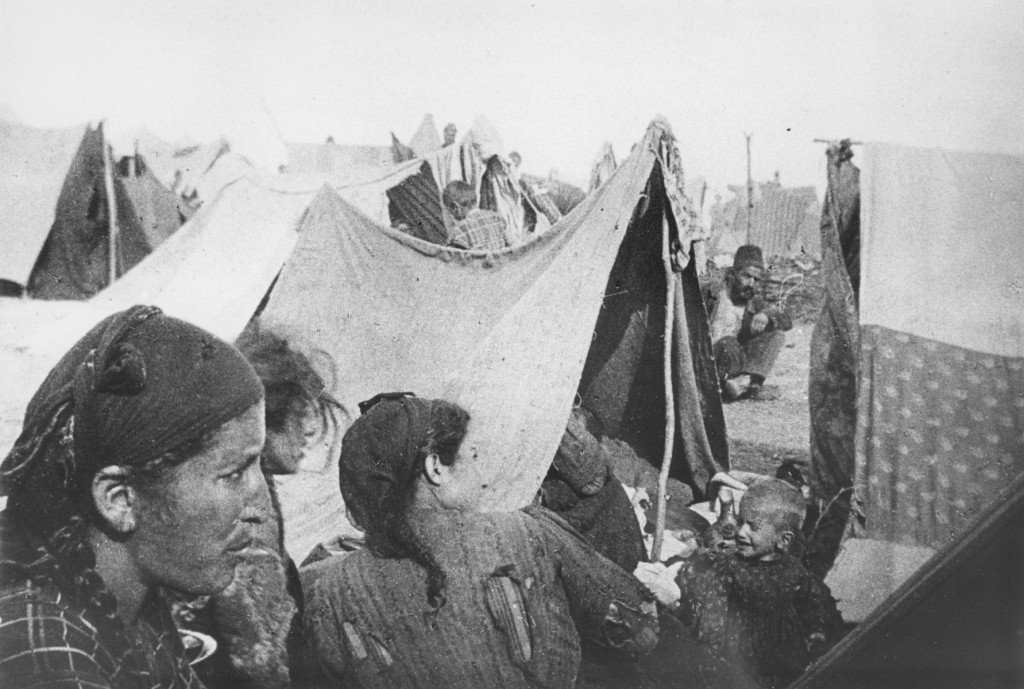
World War I and the Armenian Genocide
Mass atrocities and genocide are often perpetrated within the context of war. The Armenian genocide was closely linked to World War I in the Near East and the Russian Caucasus. Ottoman Turkey fought on the side of the Central Powers (Germany and Austria-Hungary) and against the Entente Powers (Great Britain, France, Russia, and Serbia).
World War I offered the Young Turk dictatorship (Committee on Union and Progress; CUP) an opportunity to realize its nationalist aims. Already inclined toward Germany due to economic ties, close relations between the two militaries, and compatible territorial ambitions for a war against Russia, the Young Turk government concluded a secret military agreement with the German government on August 2, 1914, and formally entered the war on the side of the Central Powers on November 11.
Beating back an initial Russian invasion, Ottoman troops invaded the Caucasus (today: Armenia and Georgia), and sought to advance their military position into the Persian Empire (today: Iran). That winter, the Turks suffered a catastrophic defeat in the Caucasus, and another at the Suez Canal in a failed attempt to push the British out of Egypt. Russian troops invaded the Ottoman Empire, moving into the east Anatolian provinces of Trabzon, Erzurum, and Van (all of which had large Armenian populations). Great Britain and France attacked the Empire during the last week of April 1915 at Gallipoli, with the aim of knocking the Ottomans out of the war.
Armenians in Conflict Zones
Although the Ottoman Empire was predominantly Muslim, there were also significant Christian populations. In the eastern provinces, Armenian Christians made up 45% of the population.
Under pressure, Ottoman military chiefs pressed for the deportation of Armenians from the war zone on the grounds that they represented a potential fifth column acting in enemy (Russian) interests. When challenged by the Entente Powers and the still neutral United States, Ottoman authorities explained the deportations as a precautionary measure.
In January 1915, the Russians routed Ottoman troops at the Battle of Sarakimis and the Ottoman 3rd Army lost more than half of its soldiers. Although Armenian soldiers in the Ottoman army generally fought loyally and bravely, CUP leaders chose to publicly blame the defeat on supposed Armenian traitors.
Forced Labor and Massacres on the Front
Retreating from positions in the Caucasus and in Persia in February–March 1915, Ottoman authorities massacred populations viewed as potentially disloyal, leading some Armenians to take up arms in self-defense. When Russian troops invaded that April, some of these armed bands joined them. Reinforced in a suspicion that all Armenians were potential traitors, Ottoman commanders disarmed their own Armenian soldiers deployed on the eastern front and imprisoned them in forced-labor battalions.
As the Russians approached in April and early May, a majority of Armenian leaders urged compliance with the Ottomans and most Armenian civilians obeyed. Nevertheless, an armed group rose against the Ottoman garrison in Van and had seized control of the city by the time the Russians arrived on May 18, 1915. The Ottoman regime saw this insurrection as confirmation of a generalized Armenian disloyalty.
Aftermath of World War I
In the aftermath of World War I, the Treaty of Sèvres provided for the creation of an Armenian state in northwestern Anatolia. The new regime of Mustafa Kemal Pasa (who took the name Atatürk) defied western powers in their efforts to partition Anatolia. Atatürk pronounced the new Republic of Turkey (within the country's present-day borders) in November 1922. The subsequent 1923 Treaty of Lausanne between Turkey and the Entente Powers omitted all references to Armenia or Armenian rights.
Although there were several aborted postwar trials, no Ottoman perpetrators were held accountable for these crimes in a court of law.

